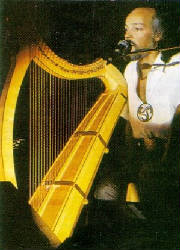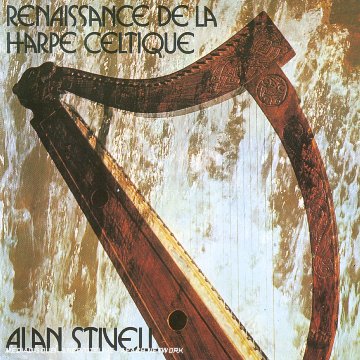|
The Bard of Brittany

1971, that's when this amazing album appeared, 1971...that was long before the rising of the many Celtic bands
that now dot the musical landscape. Renaissance de la Harpe Celtique was and is a revelation. First off it's entirely instrumental,
secondly it's an album that doesn't come from Scotland, Ireland or Wales, the usual suspects, as it were, no, this album was
from Britany. The Breton, they who fled in the face of the Anglo-Saxon invasions, they who are linguistically closer to The
Cornish than they are to the Welsh, the Irish, or the Scots. They've been killed, in the past, for daring to speak their
native tongue, as, of course have many Celts and Gaels. The music was all but gone, except in a few isolated pockets. Some
of the songs had been committed to paper, but they were held by the scholars and treated as 'interesting artifacts' to be
poured over and analysed to death. Then...then along came Jord Cochevelou, a civil servant in the French Ministry of Finance.
His dream was to recreate a Breton Celtic harp. After studying ancient documents, he reconstituted the long-forgotten
instrument, and gave the first prototype to his nine-year-old son Alan in 1953. Alan, in later years, would become known to
the world as Alan Stivell.
Alan Stivell, whose real name is Alan Cochevelou, was born on January 6 1944 at Riom, Auvergne,
France. His family, whose birthplace was Morbihan in Brittany, moved to Paris shortly afterwards.
Alan learned the classical harp and the piano. He began classes with Denise Megevand in May 1953, helped by his father. He performed for the first time in November, before an audience at the Maison de la Bretagne,
Paris, during a press conference held by his professor to show the newly created celtic harp. In 1955, he played 3 pieces
in the introduction to the Line Renaud show at the Olympia in Paris.
In 1957, young Alan began seriously learning the Breton language. He also studied celtic history, mythology
and art, thus linking up with his ancestry. He also began playing the bombarde and the Breton bagpipes, both much used
in traditional Breton music. He then joined the Bagad Bleimor folk group, where he was the lead.
His first recording experience was in 1959, when he recorded a single. It was the following year, in fact,
that his first real album came out. "Telenn Geltiek" was devoted to celtic harp music.
His father built him another harp in 1964, a bardic one with bronze strings. Alan decided to launch into
a new adventure, experimenting with modern music. In 1966, he started singing, performing in many clubs, festivals and Youth
clubs (Maisons des Jeunes et de la Culture).
Two years later, he sang the opening part of the Moody Blues concert in London. It was in 1970, however,
that the career of the singer now known as Alan Stivell began. His single, "Broceliande" came out in July under the Philips
label, followed by a later album, "Reflets", and were his first hits. In the vanguard of the folk revival, Alan Stivell offered
a version of Breton music which was resolutely modern and of the future, thus attracting a young public seeking assurance
of their regional identity, while not becoming entrapped by it.
In 1971, Stivell brought out an album entitled "Renaissance de la Harpe Celtique", which was only instrumental,
containing traditional melodies based on cords and voice, with some bombarde, percussion, even guitar accompaniment
by Dan Ar Braz. In 1972, he was acclaimed at his concert at the Olympia in Paris. With him were musicians such as Dan Ar Braz on electric
guitar, Gabriel Yacoub (later known as Malicorne), and Michel Santangeli, a rock drummer. The live album recorded at this
performance sold nearly one and a half million copies. Alan Stivell's growing success led purists to accuse him of making
music just for the sales. It was the final flash point, the world new of the true depth of Celtic music and from that point
on never looked back.
the musicians on
Renaissance de la Harpe Celtique
Alan Stivell
chant, harpes, cornemuses
Dan Ar Bras
guitare
Michel Delaporte
percussions
Guy Cascales
batterie
Gérard Levasseur,
Gérard Salkowsky guitare
Gilles Tinayre
orgue
Yann-Fanch Ar
Merdy batterie ecossaise
Mig Ar Biz, Alan
Kloatr bombarde
Jean Huchot, Henri
Delagarde,
Manuel Recassens
violoncelle
Stéphane Wiener,
Gabriel Beauvais, Paul Hadjaje,
Pierre Cheval
alto
Jean-Marc Dollez
contrebasse
|
 |
|
 |
 |

|
| Philips 6414406 1971 |
|
|
Ys
Marv Pontkalleg
Ap huw
Ap Huw and Penllyn
Eliz iza
Gaeltacht
|
|
 |
 |
 |
 |
|

|
|
related internet links
|
|
festival of music, dance
& history from Wales,
Scotland, Cornwall, Isle of Man,
Galicia, Brittany, Ireland and
Asturias
the texts on this website covers
much of the early time frame that
we'll be looking at here.
the mythology of Celtic polytheism,
the apparent religion of the
Iron Age Celts. Like other Iron Age
Europeans, the early Celts
maintained a polytheistic
mythology and
religious structure
Scotland's Online Resource Centre
for Celtic Studies, plus information
about instruments, Celtic customs
Welsh Celtic Rock Band
no fiddle, no pipes, no concertinas
but Celtic to the bone
Kuzul Etrevroadel Evit Kendalc'h
Ar Brezhoneg
established in 1975 in Brussels,
Belgium, to support the repeated
demands of Bretons that their
native language be given the
recognition and place in
the schools, media and
public life of Brittany
that it needs to survive
a collection of information on the
instruments and playing styles of
traditional Scottish and Irish music.
This is not intended to be a
complete listing of all instruments
in current use. For that, try Ceolas.
an overview of the
telenn or Breton harp.
Although most folks think
of Celtic music, in their mind
they hear Irish or Scottish music.
However.....
all things traditional
plentiful coverage of
the Celtic and Gaelic scene

|
|
 |
 |
|
 |
 |
 |
|
|
 |
 |
 |
|
|
|

